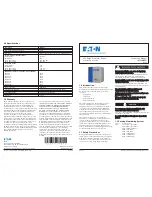
INTERFERENCE DUE TO ENVIRONMENTAL RADON
If you are sampling for radon particulate progeny and/or
thoron particulate progeny or if those might interfere with your
sampling for other airborne radioactive material you will need
to take some repetitive measurements to quantify the
radioactivity. Radon-222 is a gas in the U-238 decay chain
while Radon-220 (known as thoron) is a gas in the Th-232
decay chain.
Refer to the radioactive decay chain for uranium-238 and
thorium-232 starting with Po-218 in the U-238 chain and
starting with Pb-212 in the Th-232 chain. These particulate
progeny and their immediate progeny determine the overall
half-life of the alpha emitters in those decay chains. The
overall half-life of the particulate progeny alpha emitters in the
radon chain is 30 minutes while the overall half-life of the
particulate progeny alpha emitters in the thoron decay chain
is 10.6 hours (636 minutes).
The following table indicates the decay rates you should
observe if you measure the activity on your sample filter at
specific times and for different conditions of radon and thoron
concentrations.
The assumptions are; almost all radon, almost all thoron,
radon and thoron particulate progeny of approximately equal
levels of activity.
Measure the initial activity on the sample filter. Then perform
the measurement again at 30 minutes, 120 minutes, 240
minutes, and finally 300 minutes after you removed the filter.
182
INTERFERENCE DUE TO ENVIRONMENTAL RADON
If you are sampling for radon particulate progeny and/or
thoron particulate progeny or if those might interfere with your
sampling for other airborne radioactive material you will need
to take some repetitive measurements to quantify the
radioactivity. Radon-222 is a gas in the U-238 decay chain
while Radon-220 (known as thoron) is a gas in the Th-232
decay chain.
Refer to the radioactive decay chain for uranium-238 and
thorium-232 starting with Po-218 in the U-238 chain and
starting with Pb-212 in the Th-232 chain. These particulate
progeny and their immediate progeny determine the overall
half-life of the alpha emitters in those decay chains. The
overall half-life of the particulate progeny alpha emitters in the
radon chain is 30 minutes while the overall half-life of the
particulate progeny alpha emitters in the thoron decay chain
is 10.6 hours (636 minutes).
The following table indicates the decay rates you should
observe if you measure the activity on your sample filter at
specific times and for different conditions of radon and thoron
concentrations.
The assumptions are; almost all radon, almost all thoron,
radon and thoron particulate progeny of approximately equal
levels of activity.
Measure the initial activity on the sample filter. Then perform
the measurement again at 30 minutes, 120 minutes, 240
minutes, and finally 300 minutes after you removed the filter.
182
INTERFERENCE DUE TO ENVIRONMENTAL RADON
If you are sampling for radon particulate progeny and/or
thoron particulate progeny or if those might interfere with your
sampling for other airborne radioactive material you will need
to take some repetitive measurements to quantify the
radioactivity. Radon-222 is a gas in the U-238 decay chain
while Radon-220 (known as thoron) is a gas in the Th-232
decay chain.
Refer to the radioactive decay chain for uranium-238 and
thorium-232 starting with Po-218 in the U-238 chain and
starting with Pb-212 in the Th-232 chain. These particulate
progeny and their immediate progeny determine the overall
half-life of the alpha emitters in those decay chains. The
overall half-life of the particulate progeny alpha emitters in the
radon chain is 30 minutes while the overall half-life of the
particulate progeny alpha emitters in the thoron decay chain
is 10.6 hours (636 minutes).
The following table indicates the decay rates you should
observe if you measure the activity on your sample filter at
specific times and for different conditions of radon and thoron
concentrations.
The assumptions are; almost all radon, almost all thoron,
radon and thoron particulate progeny of approximately equal
levels of activity.
Measure the initial activity on the sample filter. Then perform
the measurement again at 30 minutes, 120 minutes, 240
minutes, and finally 300 minutes after you removed the filter.
182
INTERFERENCE DUE TO ENVIRONMENTAL RADON
If you are sampling for radon particulate progeny and/or
thoron particulate progeny or if those might interfere with your
sampling for other airborne radioactive material you will need
to take some repetitive measurements to quantify the
radioactivity. Radon-222 is a gas in the U-238 decay chain
while Radon-220 (known as thoron) is a gas in the Th-232
decay chain.
Refer to the radioactive decay chain for uranium-238 and
thorium-232 starting with Po-218 in the U-238 chain and
starting with Pb-212 in the Th-232 chain. These particulate
progeny and their immediate progeny determine the overall
half-life of the alpha emitters in those decay chains. The
overall half-life of the particulate progeny alpha emitters in the
radon chain is 30 minutes while the overall half-life of the
particulate progeny alpha emitters in the thoron decay chain
is 10.6 hours (636 minutes).
The following table indicates the decay rates you should
observe if you measure the activity on your sample filter at
specific times and for different conditions of radon and thoron
concentrations.
The assumptions are; almost all radon, almost all thoron,
radon and thoron particulate progeny of approximately equal
levels of activity.
Measure the initial activity on the sample filter. Then perform
the measurement again at 30 minutes, 120 minutes, 240
minutes, and finally 300 minutes after you removed the filter.
182








































